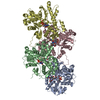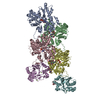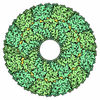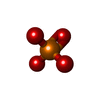[English] 日本語
 Yorodumi
Yorodumi- PDB-9fjm: Cryo-EM structure of the phalloidin-bound pointed end of the acti... -
+ Open data
Open data
- Basic information
Basic information
| Entry | Database: PDB / ID: 9fjm | ||||||||||||
|---|---|---|---|---|---|---|---|---|---|---|---|---|---|
| Title | Cryo-EM structure of the phalloidin-bound pointed end of the actin filament. | ||||||||||||
 Components Components |
| ||||||||||||
 Keywords Keywords | STRUCTURAL PROTEIN / actin / phalloidin / filament / pointed end | ||||||||||||
| Function / homology |  Function and homology information Function and homology informationpositive regulation of norepinephrine uptake / bBAF complex / cellular response to cytochalasin B / npBAF complex / nBAF complex / brahma complex / regulation of transepithelial transport / Formation of annular gap junctions / Formation of the dystrophin-glycoprotein complex (DGC) / morphogenesis of a polarized epithelium ...positive regulation of norepinephrine uptake / bBAF complex / cellular response to cytochalasin B / npBAF complex / nBAF complex / brahma complex / regulation of transepithelial transport / Formation of annular gap junctions / Formation of the dystrophin-glycoprotein complex (DGC) / morphogenesis of a polarized epithelium / structural constituent of postsynaptic actin cytoskeleton / Gap junction degradation / GBAF complex / Folding of actin by CCT/TriC / regulation of G0 to G1 transition / protein localization to adherens junction / Cell-extracellular matrix interactions / dense body / Tat protein binding / postsynaptic actin cytoskeleton / Prefoldin mediated transfer of substrate to CCT/TriC / RSC-type complex / regulation of double-strand break repair / regulation of nucleotide-excision repair / Adherens junctions interactions / RHOF GTPase cycle / adherens junction assembly / apical protein localization / Sensory processing of sound by outer hair cells of the cochlea / Interaction between L1 and Ankyrins / tight junction / SWI/SNF complex / regulation of mitotic metaphase/anaphase transition / Sensory processing of sound by inner hair cells of the cochlea / positive regulation of T cell differentiation / apical junction complex / positive regulation of double-strand break repair / maintenance of blood-brain barrier / regulation of norepinephrine uptake / nitric-oxide synthase binding / transporter regulator activity / cortical cytoskeleton / NuA4 histone acetyltransferase complex / establishment or maintenance of cell polarity / positive regulation of stem cell population maintenance / Recycling pathway of L1 / Regulation of MITF-M-dependent genes involved in pigmentation / brush border / regulation of G1/S transition of mitotic cell cycle / EPH-ephrin mediated repulsion of cells / negative regulation of cell differentiation / kinesin binding / RHO GTPases Activate WASPs and WAVEs / regulation of synaptic vesicle endocytosis / positive regulation of myoblast differentiation / RHO GTPases activate IQGAPs / regulation of protein localization to plasma membrane / positive regulation of double-strand break repair via homologous recombination / EPHB-mediated forward signaling / cytoskeleton organization / substantia nigra development / axonogenesis / calyx of Held / nitric-oxide synthase regulator activity / Translocation of SLC2A4 (GLUT4) to the plasma membrane / FCGR3A-mediated phagocytosis / actin filament / adherens junction / Regulation of endogenous retroelements by Piwi-interacting RNAs (piRNAs) / positive regulation of cell differentiation / cell motility / RHO GTPases Activate Formins / Signaling by high-kinase activity BRAF mutants / MAP2K and MAPK activation / DNA Damage Recognition in GG-NER / Regulation of actin dynamics for phagocytic cup formation / B-WICH complex positively regulates rRNA expression / kinetochore / structural constituent of cytoskeleton / Hydrolases; Acting on acid anhydrides; Acting on acid anhydrides to facilitate cellular and subcellular movement / VEGFA-VEGFR2 Pathway / platelet aggregation / Schaffer collateral - CA1 synapse / tau protein binding / nuclear matrix / cytoplasmic ribonucleoprotein granule / Signaling by RAF1 mutants / Signaling by moderate kinase activity BRAF mutants / Paradoxical activation of RAF signaling by kinase inactive BRAF / Signaling downstream of RAS mutants / cell-cell junction / Signaling by BRAF and RAF1 fusions / UCH proteinases / nucleosome / presynapse / lamellipodium / actin cytoskeleton / Clathrin-mediated endocytosis / HATs acetylate histones / Factors involved in megakaryocyte development and platelet production Similarity search - Function | ||||||||||||
| Biological species |  Homo sapiens (human) Homo sapiens (human) Amanita phalloides (death cap) Amanita phalloides (death cap) | ||||||||||||
| Method | ELECTRON MICROSCOPY / single particle reconstruction / cryo EM / Resolution: 3.65 Å | ||||||||||||
 Authors Authors | Boiero Sanders, M. / Oosterheert, W. / Hofnagel, O. / Bieling, P. / Raunser, S. | ||||||||||||
| Funding support |  Germany, European Union, 3items Germany, European Union, 3items
| ||||||||||||
 Citation Citation |  Journal: Nat Commun / Year: 2024 Journal: Nat Commun / Year: 2024Title: Phalloidin and DNase I-bound F-actin pointed end structures reveal principles of filament stabilization and disassembly. Authors: Micaela Boiero Sanders / Wout Oosterheert / Oliver Hofnagel / Peter Bieling / Stefan Raunser /  Abstract: Actin filament turnover involves subunits binding to and dissociating from the filament ends, with the pointed end being the primary site of filament disassembly. Several molecules modulate filament ...Actin filament turnover involves subunits binding to and dissociating from the filament ends, with the pointed end being the primary site of filament disassembly. Several molecules modulate filament turnover, but the underlying mechanisms remain incompletely understood. Here, we present three cryo-EM structures of the F-actin pointed end in the presence and absence of phalloidin or DNase I. The two terminal subunits at the undecorated pointed end adopt a twisted conformation. Phalloidin can still bind and bridge these subunits, inducing a conformational shift to a flattened, F-actin-like state. This explains how phalloidin prevents depolymerization at the pointed end. Interestingly, two DNase I molecules simultaneously bind to the phalloidin-stabilized pointed end. In the absence of phalloidin, DNase I binding would disrupt the terminal actin subunit packing, resulting in filament disassembly. Our findings uncover molecular principles of pointed end regulation and provide structural insights into the kinetic asymmetry between the actin filament ends. | ||||||||||||
| History |
|
- Structure visualization
Structure visualization
| Structure viewer | Molecule:  Molmil Molmil Jmol/JSmol Jmol/JSmol |
|---|
- Downloads & links
Downloads & links
- Download
Download
| PDBx/mmCIF format |  9fjm.cif.gz 9fjm.cif.gz | 265.3 KB | Display |  PDBx/mmCIF format PDBx/mmCIF format |
|---|---|---|---|---|
| PDB format |  pdb9fjm.ent.gz pdb9fjm.ent.gz | 215.7 KB | Display |  PDB format PDB format |
| PDBx/mmJSON format |  9fjm.json.gz 9fjm.json.gz | Tree view |  PDBx/mmJSON format PDBx/mmJSON format | |
| Others |  Other downloads Other downloads |
-Validation report
| Summary document |  9fjm_validation.pdf.gz 9fjm_validation.pdf.gz | 1.8 MB | Display |  wwPDB validaton report wwPDB validaton report |
|---|---|---|---|---|
| Full document |  9fjm_full_validation.pdf.gz 9fjm_full_validation.pdf.gz | 1.8 MB | Display | |
| Data in XML |  9fjm_validation.xml.gz 9fjm_validation.xml.gz | 65.1 KB | Display | |
| Data in CIF |  9fjm_validation.cif.gz 9fjm_validation.cif.gz | 92.7 KB | Display | |
| Arichive directory |  https://data.pdbj.org/pub/pdb/validation_reports/fj/9fjm https://data.pdbj.org/pub/pdb/validation_reports/fj/9fjm ftp://data.pdbj.org/pub/pdb/validation_reports/fj/9fjm ftp://data.pdbj.org/pub/pdb/validation_reports/fj/9fjm | HTTPS FTP |
-Related structure data
| Related structure data |  50506MC M: map data used to model this data C: citing same article ( |
|---|---|
| Similar structure data | Similarity search - Function & homology  F&H Search F&H Search |
- Links
Links
- Assembly
Assembly
| Deposited unit | 
|
|---|---|
| 1 |
|
- Components
Components
| #1: Protein | Mass: 41632.422 Da / Num. of mol.: 4 Source method: isolated from a genetically manipulated source Details: Beta-actin recombinantly purified from insect cells. Source: (gene. exp.)  Homo sapiens (human) / Gene: ACTB / Plasmid: p2336 pFL_ACTB_C272A / Cell line (production host): BTI-Tnao38 / Production host: Homo sapiens (human) / Gene: ACTB / Plasmid: p2336 pFL_ACTB_C272A / Cell line (production host): BTI-Tnao38 / Production host:  Trichoplusia ni (cabbage looper) / References: UniProt: P60709 Trichoplusia ni (cabbage looper) / References: UniProt: P60709#2: Protein/peptide | Type: Peptide-like / Class: Toxin / Mass: 808.899 Da / Num. of mol.: 4 / Source method: isolated from a natural source / Details: phalloidin from Amanita phalloides. / Source: (natural)  Amanita phalloides (death cap) / References: BIRD: PRD_002366 Amanita phalloides (death cap) / References: BIRD: PRD_002366#3: Chemical | ChemComp-ADP / #4: Chemical | ChemComp-MG / #5: Chemical | ChemComp-PO4 / Has ligand of interest | Y | |
|---|
-Experimental details
-Experiment
| Experiment | Method: ELECTRON MICROSCOPY |
|---|---|
| EM experiment | Aggregation state: PARTICLE / 3D reconstruction method: single particle reconstruction |
- Sample preparation
Sample preparation
| Component |
| ||||||||||||||||||||||||||||||
|---|---|---|---|---|---|---|---|---|---|---|---|---|---|---|---|---|---|---|---|---|---|---|---|---|---|---|---|---|---|---|---|
| Molecular weight |
| ||||||||||||||||||||||||||||||
| Source (natural) |
| ||||||||||||||||||||||||||||||
| Source (recombinant) | Organism:  Trichoplusia ni (cabbage looper) / Cell: BTI-Tnao38 Trichoplusia ni (cabbage looper) / Cell: BTI-Tnao38 | ||||||||||||||||||||||||||||||
| Buffer solution | pH: 7.1 Details: 1xKMEH (10 mM HEPES pH 7.1, 100 mM KCl, 2 mM MgCl2, 1 mM EGTA, 0.5 mM TCEP) | ||||||||||||||||||||||||||||||
| Buffer component |
| ||||||||||||||||||||||||||||||
| Specimen | Embedding applied: NO / Shadowing applied: NO / Staining applied: NO / Vitrification applied: YES | ||||||||||||||||||||||||||||||
| Specimen support | Grid material: GOLD / Grid mesh size: 200 divisions/in. / Grid type: Quantifoil R2/1 | ||||||||||||||||||||||||||||||
| Vitrification | Instrument: FEI VITROBOT MARK IV / Cryogen name: ETHANE-PROPANE / Humidity: 100 % / Chamber temperature: 286 K / Details: 3 seconds, force 0. |
- Electron microscopy imaging
Electron microscopy imaging
| Experimental equipment |  Model: Titan Krios / Image courtesy: FEI Company |
|---|---|
| Microscopy | Model: FEI TITAN KRIOS Details: 300 kV Titan Krios G2 microscope (Thermo Fisher Scientific) with an in-column Cs-corrector. |
| Electron gun | Electron source:  FIELD EMISSION GUN / Accelerating voltage: 300 kV / Illumination mode: FLOOD BEAM FIELD EMISSION GUN / Accelerating voltage: 300 kV / Illumination mode: FLOOD BEAM |
| Electron lens | Mode: BRIGHT FIELD / Nominal magnification: 81000 X / Nominal defocus max: 2700 nm / Nominal defocus min: 1200 nm / Cs: 0.01 mm / C2 aperture diameter: 50 µm |
| Specimen holder | Cryogen: NITROGEN / Specimen holder model: FEI TITAN KRIOS AUTOGRID HOLDER |
| Image recording | Electron dose: 64.6 e/Å2 / Film or detector model: GATAN K3 BIOQUANTUM (6k x 4k) / Num. of grids imaged: 1 / Num. of real images: 20393 |
| EM imaging optics | Energyfilter name: GIF Bioquantum / Details: Gatan energy filter. / Energyfilter slit width: 15 eV Spherical aberration corrector: Titan Krios G2 microscope (Thermo Fisher Scientific) with an in-column Cs-corrector. |
- Processing
Processing
| EM software |
| ||||||||||||||||||||||||||||||||||||||||||||||||
|---|---|---|---|---|---|---|---|---|---|---|---|---|---|---|---|---|---|---|---|---|---|---|---|---|---|---|---|---|---|---|---|---|---|---|---|---|---|---|---|---|---|---|---|---|---|---|---|---|---|
| CTF correction | Type: PHASE FLIPPING AND AMPLITUDE CORRECTION | ||||||||||||||||||||||||||||||||||||||||||||||||
| Particle selection | Num. of particles selected: 5200600 / Details: Particles picked using SPHIRE-crYOLO. | ||||||||||||||||||||||||||||||||||||||||||||||||
| Symmetry | Point symmetry: C1 (asymmetric) | ||||||||||||||||||||||||||||||||||||||||||||||||
| 3D reconstruction | Resolution: 3.65 Å / Resolution method: FSC 0.143 CUT-OFF / Num. of particles: 280802 / Details: Local Refinement in CryoSPARC. / Symmetry type: POINT | ||||||||||||||||||||||||||||||||||||||||||||||||
| Atomic model building | Protocol: FLEXIBLE FIT / Space: REAL | ||||||||||||||||||||||||||||||||||||||||||||||||
| Atomic model building | PDB-ID: 8rtt Accession code: 8rtt / Details: actin and phalloidin model / Source name: PDB / Type: experimental model | ||||||||||||||||||||||||||||||||||||||||||||||||
| Refine LS restraints |
|
 Movie
Movie Controller
Controller








 PDBj
PDBj























